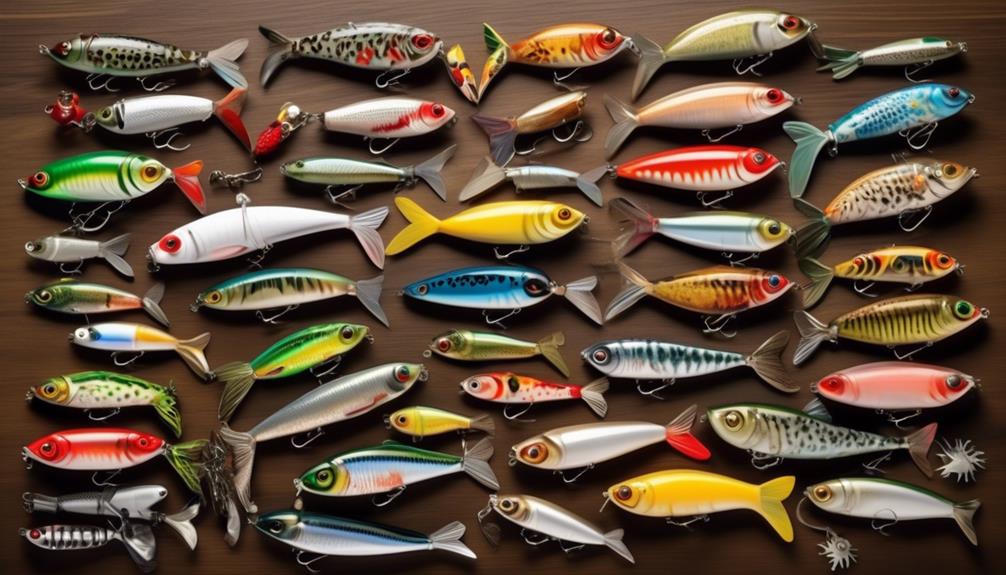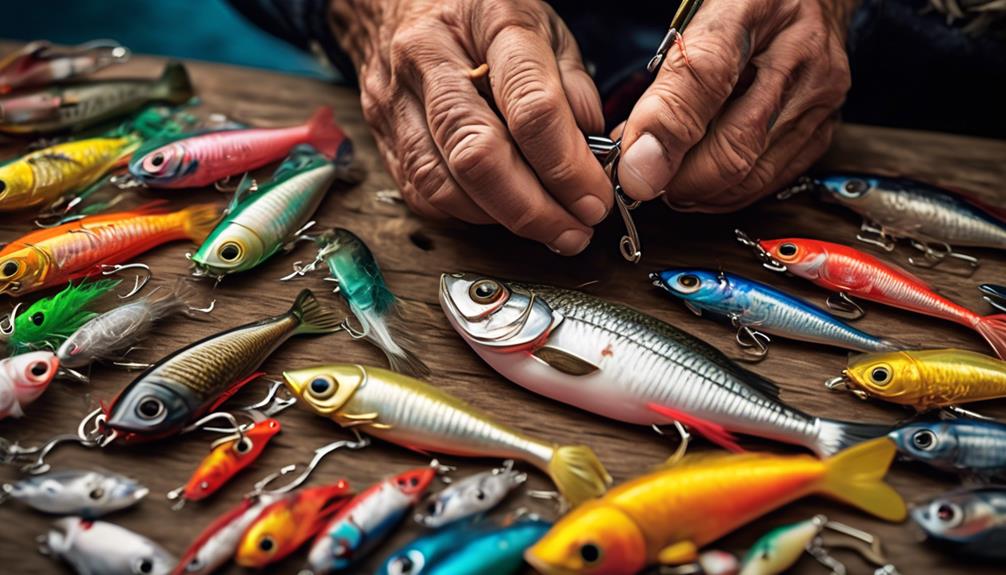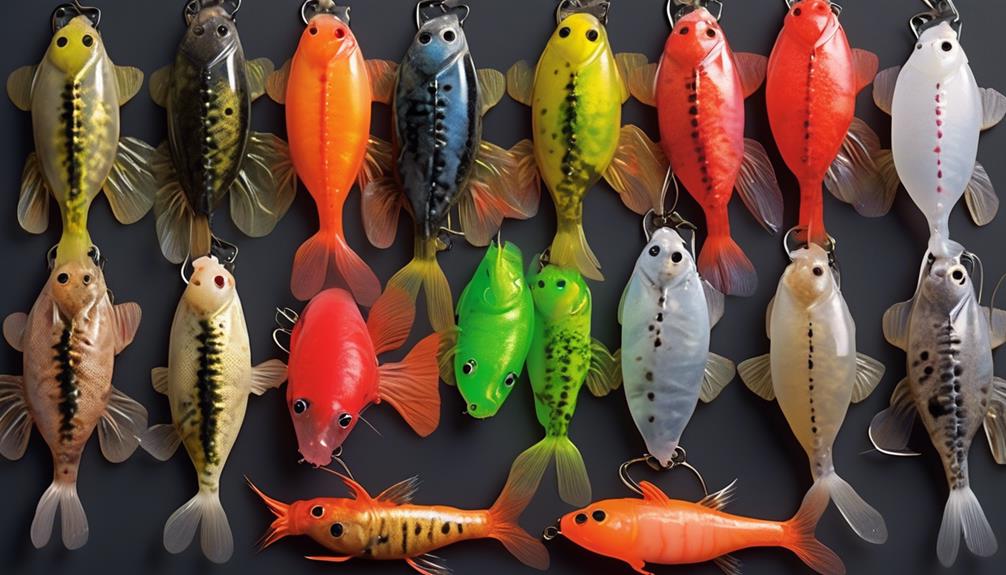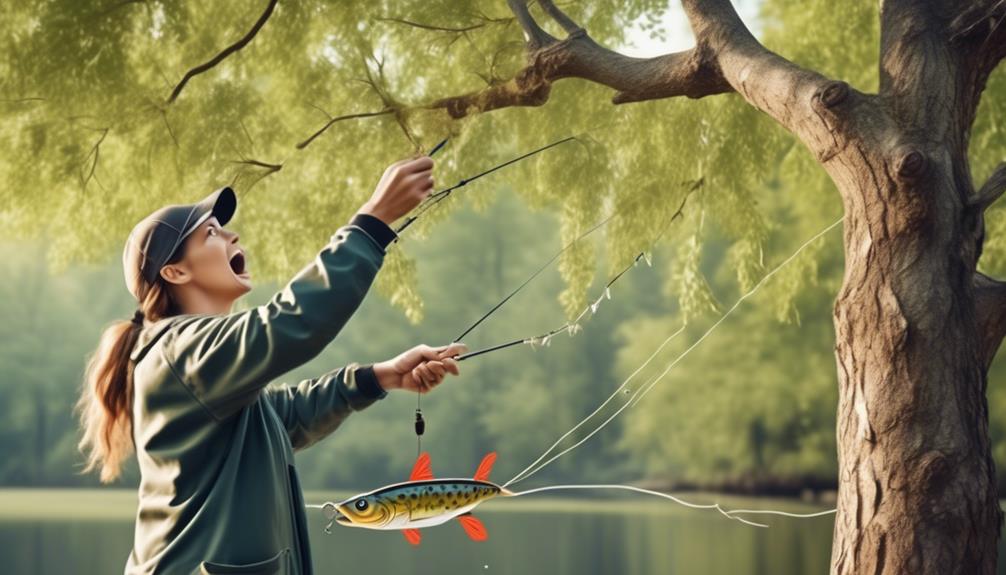Have you ever found yourself frustrated after a day of fishing, unable to entice the fish to bite? It's a common experience, but fear not – there are ways to increase your chances of success.
Selecting the right lure for the fish species you're targeting is an art and a science. With 13 expert tips, you'll be armed with the knowledge to make informed decisions when it comes to lures.
So, are you ready to discover the secrets that will help you reel in more fish on your next outing?
Understanding Fish Behavior
To increase your success in selecting the right lures for various fish species, it's crucial to understand the behavior of the fish you're targeting. Fish movement patterns play a significant role in determining the most effective lures for different species.
For example, predatory fish like bass tend to be more active in the early morning and late afternoon, so using topwater lures that mimic injured baitfish can be highly effective during these times. On the other hand, understanding feeding patterns is essential for targeting bottom-feeding fish like catfish. These fish are more likely to respond to lures that mimic natural bottom-dwelling prey, such as worms or crayfish.
By studying fish movement patterns, you can determine the most effective lures for specific times of the day and locations.
For instance, if you're targeting trout in a river, understanding their upstream movement patterns during certain times of the year can help you position yourself strategically and use lures that simulate the insects or small fish they typically feed on. Similarly, when targeting fish in open water, understanding their circular movement patterns can help you choose lures that cover a wider area to increase the chances of attracting a bite.
Matching Lure Types to Fish
When selecting lures for various fish species, consider the specific characteristics and behaviors of the fish you're targeting to determine the most suitable lure types. Matching the right lure types to the fish you're aiming to catch can significantly increase your chances of success. Here are some key points to keep in mind:
- Lure Presentation: Different fish species respond to various types of lure presentations. For example, predatory fish like bass are often enticed by lures that mimic injured baitfish, so using crankbaits or swimbaits with erratic and lively movements can be effective. On the other hand, for species like trout that are more sensitive to movement, using subtle presentations such as soft plastic worms or inline spinners can yield better results.
- Fish Feeding Patterns: Understanding the feeding patterns of the fish you're targeting is crucial in selecting the right lure type. For instance, if you're targeting bottom-feeding fish like catfish or flounder, using lures that can reach the bottom and imitate natural prey like worms or crustaceans is essential. Conversely, if you're angling for surface-feeding fish such as topwater-feeding bass or trout, using topwater lures like poppers or frogs can be highly effective.
- Adaptability: Some lures are designed to be versatile and can be effective for a wide range of fish species. For example, soft plastic swimbaits can be used to target bass, pike, walleye, and even saltwater species like redfish, making them a valuable addition to any angler's tackle box.
Consideration of Water Conditions
Considering the water conditions is crucial when selecting lures for different fish species, as it directly impacts the effectiveness of your fishing approach. One of the key factors to take into account is the weather patterns.
In clear and sunny conditions, fish may be more active and visible near the water's surface. In such cases, using topwater lures like poppers or surface walkers can be highly effective.
On the other hand, during overcast or rainy weather, fish tend to move to deeper waters. In these conditions, diving lures that can reach greater depths, such as crankbaits or diving plugs, are more suitable for enticing bites.
Another important consideration is water clarity. In clear water, fish rely heavily on their vision to locate prey. Therefore, using lures with natural colors and realistic movements can yield better results. Soft plastic worms or lures with lifelike swimming actions are great choices for clear water conditions.
Conversely, in murky or stained water, where visibility is reduced, lures with rattles or bright, flashy colors can attract fish by creating vibrations and drawing attention to the lure.
Color Selection for Lures
Considering the water conditions is essential for effective lure selection, and one crucial aspect to address is the color of the lure. When it comes to choosing the right color for your lure, there are several important factors to keep in mind to increase your chances of a successful catch.
Here are three key points to consider when selecting the color of your lure:
- Color Psychology: Fish, like humans, can be influenced by color. Using colors that contrast with the surrounding water can make your lure stand out and attract more attention from the fish. Bright colors such as chartreuse, orange, or pink can be particularly effective in murky or stained waters. On the other hand, natural colors like green, brown, or silver can work well in clear water conditions. Understanding the psychology of color can help you choose the most appealing colors for the fish you're trying to catch.
- Color Theory: Consider the color of the surroundings where you'll be fishing. If the water is clear and the surroundings are mainly green, using a lure with green or silver hues can help it blend in and appear more natural to the fish. Conversely, in muddy or dark waters, a brighter and more contrasting color can make your lure more visible and attractive to the fish.
- Fish Vision: Different fish species have varying abilities to perceive color. For example, some fish can see a wide range of colors, while others may have limited color vision. Understanding the vision capabilities of the fish you're targeting can help you choose the most effective lure colors to enhance your presentation.
Lure Size and Shape Matters
The size and shape of your lure significantly impact its effectiveness in attracting and enticing various fish species. When it comes to lure presentation, it's crucial to consider the specific species you're targeting. Different fish have different feeding habits and preferences, so selecting the right size and shape can make a significant difference in your fishing success.
For instance, if you're fishing for bass in a heavily weeded area, a weedless frog lure with a compact, streamlined shape will allow you to maneuver through the vegetation, increasing your chances of a successful catch. On the other hand, if you're targeting trout in a clear, open stream, a smaller, more natural-looking lure may be more effective in mimicking their typical prey.
The size of the lure also matters when targeting specific species. Larger lures are often more appealing to predatory fish such as pike or muskie, as they mimic the size of the prey these fish typically hunt. Meanwhile, smaller lures may be more suitable for enticing panfish like crappie or bluegill.
Evaluating Lure Action
To determine the effectiveness of a lure, observe how it moves through the water and how the fish respond to its action. Paying close attention to the lure's movement and the fish's reaction will help you evaluate its performance and make adjustments as needed. Here are three key factors to consider when evaluating lure action:
- Natural Movement: Watch how the lure mimics the natural movement of prey in the water. A good lure will move in a way that entices fish to strike, resembling the motions of the fish's usual prey. Look for realistic swimming or darting motions that can attract the attention of nearby fish.
- Attractant Response: Observe how fish respond to the lure's action. Are they following the lure, striking at it, or ignoring it completely? Understanding the fish's response will help you determine if the lure's action is effectively attracting the targeted species.
- Versatility: Evaluate the lure's ability to adapt to different water conditions and fish behaviors. A versatile lure should be able to create different actions to appeal to various fish species and environmental factors. Whether it's a steady retrieve, erratic jerks, or pauses, the lure should be able to adapt and attract fish in different situations.
Researching Fish Feeding Habits
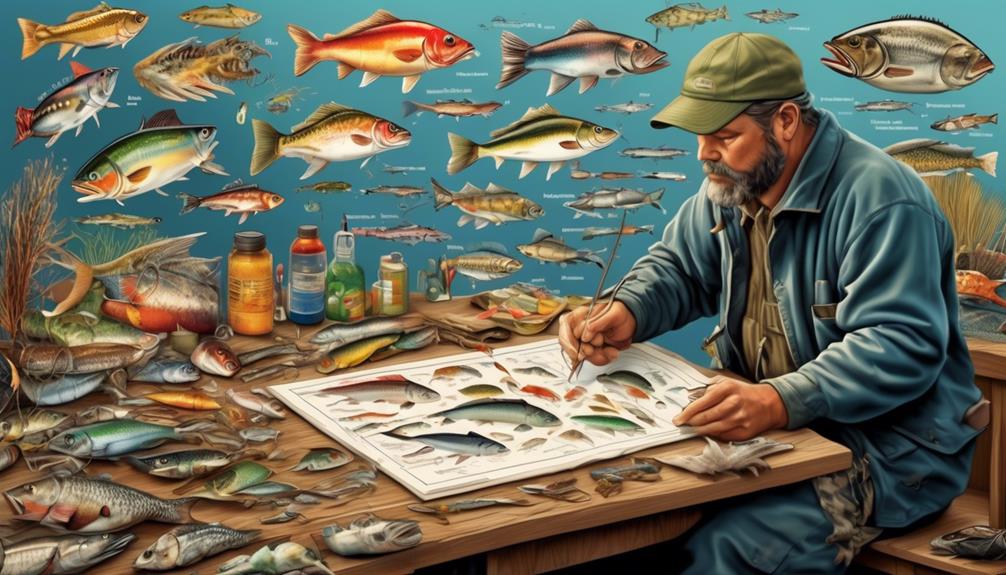
When researching fish feeding habits, observe their natural behaviors and preferred prey to understand their feeding patterns. Conduct a fish diet analysis to determine the primary food sources for the species you're targeting. This analysis can provide valuable insights into the types of lures and baits that are most likely to attract the fish.
Additionally, consider the fishing location as different environments offer varying food sources. Understanding the seasonal feeding patterns is crucial as fish behavior changes throughout the year. For instance, in colder months, fish may be more sluggish and less likely to chase fast-moving lures. In contrast, during warmer months, they may be more active and responsive to lively bait presentation.
To improve your chances of success, it's essential to research the specific feeding habits of the fish species you're targeting. Some fish are opportunistic feeders, consuming a wide range of prey, while others have more selective diets. By understanding these nuances, you can tailor your lure selection and fishing techniques accordingly.
Observing the natural feeding behaviors of fish in their habitat can provide valuable clues about the most effective ways to entice them. Ultimately, the more you know about a fish's feeding habits, the better equipped you'll be to choose the right lures and present them in a way that's most likely to trigger a strike.
Adapting Lures to Fishing Techniques
As you observe and understand the natural feeding behaviors and preferred prey of the fish species you're targeting, you can adapt your lure selection to best match the fishing techniques you plan to employ. This adaptation is crucial for increasing your chances of a successful catch.
Here are some ways to adapt your lures to your fishing techniques:
- Lure Retrieval: The speed and style of retrieving your lure can greatly influence its effectiveness. If you're targeting fish species that prefer fast-moving prey, such as bass or pike, consider using lures that allow for quick and erratic retrieval. On the other hand, for species like trout or walleye that are more inclined to go after slower-moving bait, opt for lures that can be retrieved at a steadier pace with occasional pauses to mimic injured or struggling prey.
- Bait Presentation: Different fishing techniques require varying bait presentations. For example, if you're using topwater lures and aiming for surface-feeding fish, mastering the art of creating enticing movements on the water's surface is crucial. On the other hand, when employing jigging techniques, ensuring that your lure mimics the natural movements of the targeted prey is essential for attracting the attention of bottom-dwelling fish species.
- Depth Control: Adjusting the weight of your lure and the retrieval depth is vital for matching your fishing technique. For instance, if you're employing deep-sea fishing techniques, using heavy lures and adjusting the retrieval depth to reach the desired level in the water column is essential for enticing deep-dwelling fish species.
Frequently Asked Questions
Can Lures Be Used for All Fish Species, or Are There Specific Types of Fish That Are More Attracted to Lures?
Lures can be effective for many fish species, but different types of lures appeal to different fish behaviors. Understanding the types of lures and how they attract fish is key to your fishing success.
Some fish may be more attracted to certain types of lures based on their natural feeding habits, so it's important to select lures that mimic the prey of the fish you're targeting.
Are There Any Regulations or Restrictions on the Types of Lures That Can Be Used for Certain Fish Species in Different Locations?
When selecting lures for different fish species in various locations, it's important to consider regulations and restrictions. Some areas may have specific rules on the types of lures that can be used, so it's crucial to be aware of these guidelines.
Additionally, environmental factors such as pollution and temperature can impact the effectiveness of your lures. By understanding the regulations and considering environmental factors, you can develop effective strategies for selecting lures in different locations.
How Do Environmental Factors, Such as Pollution or Temperature Changes, Affect the Effectiveness of Lures for Different Fish Species?
Environmental impact, such as pollution and temperature changes, can greatly affect the effectiveness of lures for different fish species. Pollution can reduce fish species attraction to lures, while temperature changes can alter fish behavior and feeding patterns. These environmental factors can also influence lure regulations in certain locations.
It's important to consider these factors when selecting lures for various fish species to maximize your fishing success.
Are There Any Specific Techniques or Strategies for Using Lures to Target Multiple Fish Species in the Same Area?
To target multiple fish species in the same area, specific lure techniques can be effective. Vary your retrieval speed and depth to appeal to different species.
Use versatile lures that mimic various prey, such as crankbaits or swimbaits. Area specific lures, like those designed for both shallow and deep water, can also help.
Experiment with different colors and sizes to find what works best for the mix of species in your fishing spot.
What Are Some Common Mistakes That Anglers Make When Selecting Lures for Different Fish Species, and How Can These Be Avoided?
When selecting lures for different fish species, it's common to make mistakes like using the wrong size or color. To avoid this, research the specific species and their feeding habits.
Another mistake isn't considering the environmental impact of the lure material. Choose lures made from sustainable materials to minimize harm.
Lastly, anglers often overlook the effectiveness of the lure in the given environment. Test different lures to find the most effective for the area.
Conclusion
So next time you're out on the water, remember these tips for selecting the right lures for different fish species.
By understanding fish behavior, matching lure types, considering water conditions, selecting the right colors, and evaluating size and shape, you'll be well on your way to catching more fish.
Take the time to research fish feeding habits and adapt your lures to different fishing techniques.
With these tips in mind, you'll be well-prepared for a successful day of fishing.
